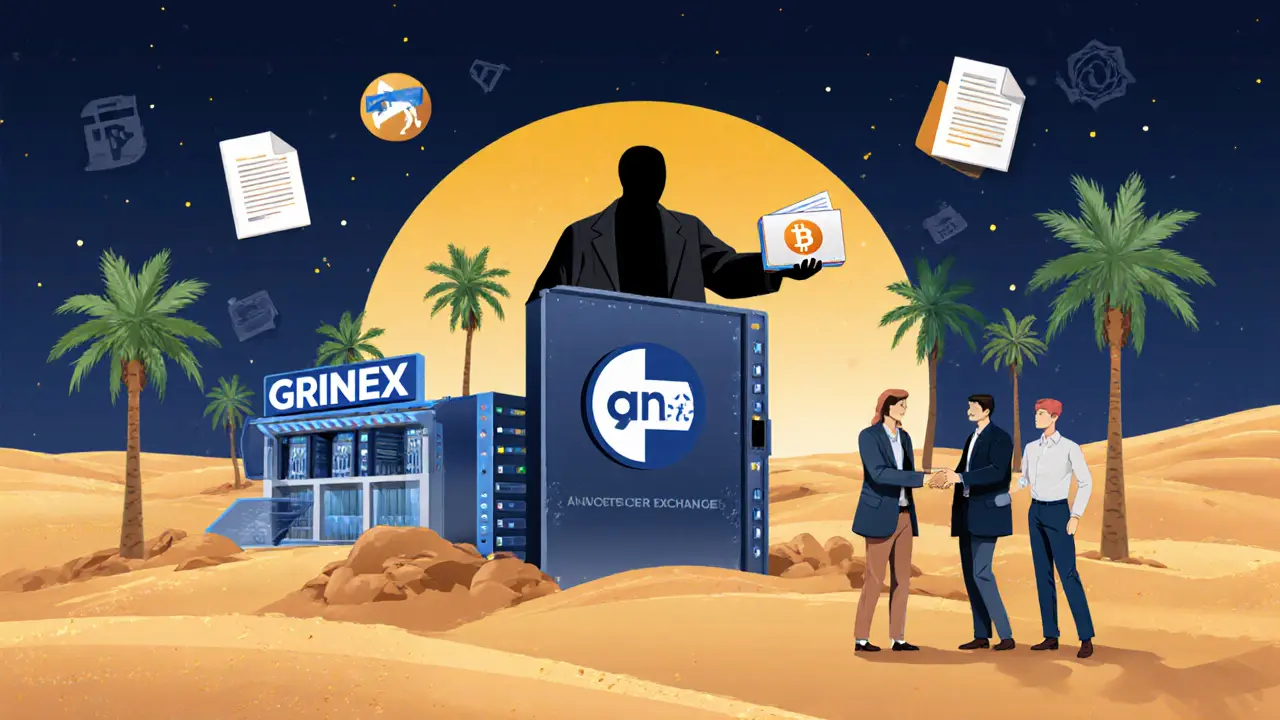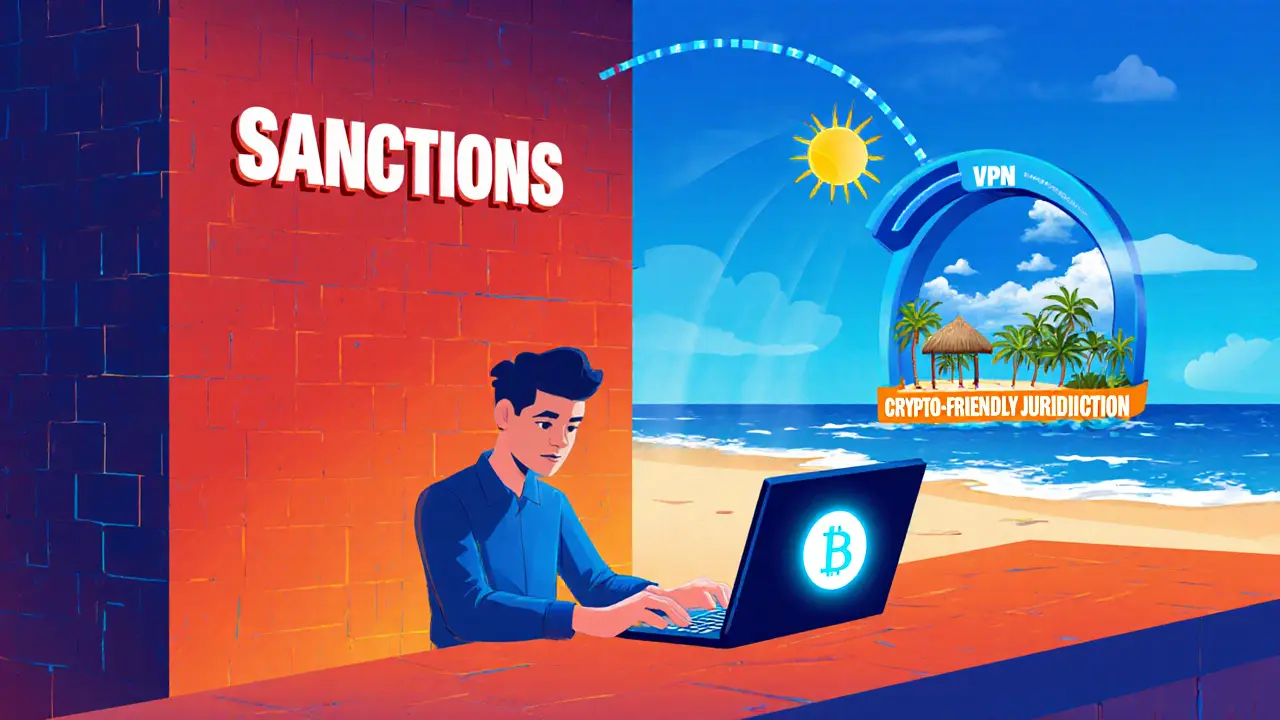Sanctioned Crypto Access Evasion Tool
Evasion Technique Comparison
Select a method below to see detailed risk analysis and detection difficulty rating.
Please select an evasion method to view its risk analysis and detection difficulty.
Risk Assessment Matrix
| Method | Typical Users | Detection Difficulty | Primary Risk |
|---|---|---|---|
| VPN / Residential Proxy | Retail traders | 2/5 | IP blocking, account freeze |
| Decentralized Exchange (Uniswap, SushiSwap) | Tech-savvy users | 4/5 | Smart-contract bugs, gas fees |
| Successor Exchange (Grinex, MKAN Coin) | Organized groups | 3/5 | Regulatory takedown, domain seizure |
| Cross-chain Bridge to Polygon | Both retail & institutional | 3/5 | Bridge exploits, freeze on target chain |
| Offshore Onboarding (Exved) | Business users | 2/5 | Bank freeze, AML reporting |
When people live under U.S. sanctions, buying or selling Bitcoin, Ethereum, or stablecoins on mainstream platforms can feel impossible. Yet a whole underground ecosystem has emerged to keep crypto flowing across borders. This guide breaks down the most common ways citizens in sanctioned nations still reach crypto exchanges, what regulators are doing to stop them, and which tactics carry the biggest risks.
Key Takeaways
- Sanctioned users rely on VPNs, decentralized platforms, and offshore services to hide their location.
- Successors like Grinex appear whenever a sanctioned exchange is seized.
- Regulators target both centralized exchanges and DeFi protocols, but users quickly shift to newer networks.
- Stablecoins remain the most vulnerable asset class, with freezes prompting rapid migrations to alternatives such as DAI on Polygon.
- Understanding the technical and legal landscape helps users avoid costly freezes and legal exposure.
Why Sanctions Matter for Crypto Traders
Sanctioned‑country crypto users are individuals living in nations that the U.S. Treasury’s Office of Foreign Assets Control (OFAC) has listed as supporters of illicit activity. As of 2025, OFAC has named over 57 individuals and entities for crypto‑related offenses, with North Korea, Russia and Iran accounting for the bulk of designations.
When a user in one of these countries tries to open an account on a U.S.‑based exchange, the platform’s AML/KYC checks typically flag the IP address, passport details, or bank connections. If the exchange cannot verify that the person is not on the Specially Designated Nationals (SDN) list, it must block the account, freeze assets, and report the activity to OFAC.
Failing to comply can cost an exchange millions in fines-ShapeShift paid $750,000 in 2025 for allowing users from Cuba, Iran, Sudan and Syria to trade. For the individual, a frozen wallet can mean losing months of earnings or, in extreme cases, criminal charges under local anti‑money‑laundering laws.
Typical Access Vectors
Even with strict enforcement, users find ways around the barriers. Below are the most common technical routes:
- VPNs and residential proxies - By routing traffic through servers in crypto‑friendly jurisdictions (e.g., Singapore or the UAE), users mask their true IP address and appear to meet KYC location requirements.
- Decentralized exchanges (DEXs) - Platforms like Uniswap or SushiSwap run on Ethereum and do not require identity verification. Users can trade directly from a wallet address without ever contacting a centralized service.
- Off‑shore onboarding services - Companies such as Exved act as payment bridges, allowing users to fund a foreign wallet with local fiat, then trade on a global exchange.
- Successor exchanges - When a sanctioned platform is seized, its operators often launch a clone under a new domain. The Russian exchange Garantex resurfaced as Grinex after a March 2025 takedown.
- Cross‑chain bridges - Users move assets from a blocked chain (e.g., Binance Smart Chain) to a less‑scrutinized network like Polygon, then swap into a stablecoin that isn’t under immediate freeze.
Transaction data shows Bitcoin accounts for roughly 65% of activity linked to sanctioned wallets, Ethereum 18%, and stablecoins 12% (mostly USDT). The high share of Bitcoin reflects its anonymity, while stablecoins are targeted because they can be quickly moved into fiat.
Case Study: Iran’s USDT Freeze and the Polygon Migration
On July22025, Tether froze 42 addresses tied to the Iranian exchange Nobitex. The move wiped out billions in USDT holdings for retail traders and a handful of institutional players.
Within hours, online forums and crypto influencers shared a step‑by‑step guide to swap the frozen USDT for DAI on the Polygon network. Users connected their wallets to a Polygon‑based DEX, exchanged USDT for DAI, and then withdrew the DAI to offshore wallets that were not subject to the Tether freeze.
The rapid pivot illustrates two key points: (1) stablecoin freezes trigger immediate community responses, and (2) cross‑chain bridges are now a primary lifeline for sanctioned users.

Successor Platforms: How Garantex Became Grinex
When U.S. Secret Service agents, together with German and Finnish police, seized Garantex’s domain and froze $26million in March2025, the exchange’s user base didn’t disappear. The operators migrated their codebase, user database, and liquidity pools to a new domain, rebranding as Grinex.
Grinex operates from a server farm in Dubai, uses a Turkish‑registered company for compliance paperwork, and requires a “phone‑only” KYC step that bypasses passport verification. This model-leveraging offshore jurisdictions while keeping the same backend-has become a template for many sanctioned exchanges.
Other examples include MKAN Coin, a Telegram‑based exchange in Dubai that mirrors Garantex’s order books, and Exved, which provides the fiat‑to‑crypto gateway for both platforms.
Enforcement Landscape: OFAC, INTERPOL, and DeFi Targets
Regulators are no longer focusing only on centralized platforms. In January2025, OFAC placed its first sanction on a DeFi protocol, freezing $150million in assets linked to a mixer that helped launder sanctioned funds. Since then, mixers inspired by Tornado Cash have faced five major enforcement actions in 2024 alone.
The total value of illicit crypto transactions tied to sanctioned entities hit $6.9billion over the past two years. Penalties levied on crypto businesses rose 40% in 2024, reaching $430million.
International cooperation is intensifying. INTERPOL and Europol now maintain a shared watchlist of over 1,200 crypto wallet addresses flagged by OFAC, making it easier to trace cross‑border flows.
Comparison of Evasion Techniques
| Method | Typical Users | Detection Difficulty (1‑5) | Primary Risk |
|---|---|---|---|
| VPN / Residential Proxy | Retail traders | 2 | IP blocking, account freeze |
| Decentralized Exchange (Uniswap, SushiSwap) | Tech‑savvy users | 4 | Smart‑contract bugs, gas fees |
| Successor Exchange (Grinex, MKAN Coin) | Organized groups | 3 | Regulatory takedown, domain seizure |
| Cross‑chain Bridge to Polygon | Both retail & institutional | 3 | Bridge exploits, freeze on target chain |
| Off‑shore onboarding (Exved) | Business users | 2 | Bank freeze, AML reporting |
Safe Practices and Mitigation Tips
- Use multi‑hop VPNs and rotate exit nodes regularly to avoid IP‑based bans.
- Prefer DEXs on networks with active security audits (e.g., Polygon, Arbitrum).
- Keep a small emergency reserve of a privacy‑focused stablecoin (e.g., DAI) that can be moved instantly if a freeze occurs.
- Split holdings across several wallets and chains; never store all assets on a single exchange.
- Stay informed on OFAC updates-new designations are announced monthly and can affect previously safe addresses.
Future Outlook: An Arms Race
The data shows an 18% annual growth rate in crypto‑related sanctions. Enforcement bodies are expanding their reach into DeFi, while users are simultaneously building more resilient, multi‑chain workarounds. Expect more sanctions against bridging protocols, and more “successor” exchanges launching from offshore hubs.
For citizens in sanctioned nations, the key to staying afloat is diversification-both in assets (Bitcoin, Ethereum, DAI) and in access points (VPNs, DEXs, offshore onboarding). Those who adapt quickly can continue trading, while those who rely on a single platform risk sudden freezes or legal trouble.

Frequently Asked Questions
Can I use a regular VPN to access a US exchange?
A basic VPN can hide your IP, but most exchanges also check device fingerprints and KYC documents. If they spot inconsistencies, they will still block the account.
Is trading on a DEX completely risk‑free for sanctioned users?
DEXs don’t require ID, but they expose you to smart‑contract bugs and higher transaction fees. Also, if a regulator targets the underlying blockchain, the assets could be frozen at the protocol level.
What happened after the Tether freeze on Iranian addresses?
Users quickly swapped USDT for DAI on Polygon, then moved the DAI to offshore wallets. This migration reduced exposure to future USDT freezes.
Are successor exchanges like Grinex legal?
Legality depends on the jurisdiction. If the platform processes transactions for sanctioned persons, U.S. law still applies, and authorities can target the offshore entity, as they did with Garantex.
How can I protect my crypto from future sanctions?
Diversify across multiple blockchains, keep a portion in privacy‑oriented stablecoins, and regularly monitor OFAC’s SDN list for new wallet addresses.


Using a VPN is a quick win for most traders looking to dodge geo‑blocks.
True, a VPN can mask your IP, but remember to pick a provider with solid privacy policies.
Switching servers regularly adds another layer of anonymity.
Just keep an eye on latency; it can affect trade execution.
Decentralized exchanges like Uniswap and SushiSwap truly empower users in sanctioned regions by removing the KYC bottleneck.
Because they operate purely on smart contracts, there is no central authority to freeze accounts.
However, this freedom comes with its own set of technical challenges that many newcomers underestimate.
First, the gas fees on Ethereum can spike dramatically during network congestion, eroding thin profit margins.
Second, the code of the contracts themselves may contain hidden vulnerabilities that attackers can exploit.
Third, regulators are increasingly monitoring blockchain activity through analytics firms, which can deanonymize addresses over time.
Fourth, bridge protocols that move assets between chains are frequent targets of hacks, as seen in multiple high‑profile incidents.
Fifth, front‑running bots can siphon off trades before retail users get a chance to execute.
Sixth, wallet security is paramount; a compromised private key instantly hands over control to a malicious actor.
Seventh, the lack of recourse means that if a smart contract fails, users generally cannot claim refunds.
Eighth, some DEX aggregators embed hidden fees within routing algorithms, subtly reducing net returns.
Ninth, without proper metadata obscuring tools, transaction patterns can be linked back to a single entity.
Tenth, the learning curve for managing token approvals and slippage settings can be steep for the uninitiated.
Eleventh, geographic censorship may still manifest through ISP‑level blocking of known blockchain node IPs.
Finally, while DEXs offer a path around sanctions, they also expose users to a complex risk landscape that demands diligent research and constant vigilance.
Absolutely, the technical barriers can feel overwhelming, but with the right guidance anyone can navigate them.
Start by securing a hardware wallet and using a reputable VPN; those two steps alone reduce most exposure.
From there, explore DEXs on testnets first to build confidence before committing real capital.
One cannot simply parade a list of evasion methods and expect the discerning reader to be satisfied; the discourse demands depth.
The superficial enumeration of VPNs versus bridges betrays a lack of strategic foresight.
In reality, the true art lies in layering these techniques-combining a residential proxy with a cross‑chain bridge yields a multiplicative effect on anonymity.
Moreover, neglecting the legal ramifications of offshore onboarding reveals a naïve attitude toward regulatory arbitrage.
Thus, any practitioner serious about preserving operational continuity must adopt a holistic, multi‑vector approach.
Great points!,, I totally agree,, you should always,, double‑check your VPN provider's logging policy,, because,, logs = risk!,, Also,, keep your software up‑to‑date,, security patches are crucial,, typo note: make sure your wallet address is correct,, otherwise,, you lose funds!!
The cavalier glorification of "off‑shore onboarding" reeks of a bourgeois superficiality that overlooks the intricate web of correspondent banking sanctions.
While the critique is valid it could benefit from a more balanced tone.
Esteemed colleagues, it is imperative that we approach cross‑chain bridging with both prudence and optimism; by meticulously auditing bridge contracts, we can mitigate exploit risk while unlocking unprecedented liquidity pathways.
Oh sure, because trusting a bridge that's been hacked twice already is exactly the kind of genius move that keeps the crypto utopia alive.
We should just close our eyes, ignore the audit reports, and hope the magic fairy of decentralization will swoop in and fix everything.
After all, who needs due diligence when you have dazzling promises and rainbow‑colored tokens?
Meanwhile, the regulators are probably busy knitting sweaters, so no one will notice the breach.
Enjoy the ride, folks; the roller coaster of risk is part of the fun.
In the grand tapestry of digital finance, the bridge serves not merely as a conduit but as a philosophical statement-transcending borders while remaining tethered to fragility.🙂
Really? Another rant about sanctions when the real problem is the lazy crypto crowd who think a VPN is a magic shield. It's obvious nobody reads the fine print, so why bother? The system will crush you anyway, so just accept defeat.
Honestly, every time I read about these so‑called “evasion tools,” I feel like I'm watching a thriller where the villains are the regulators and the heroes are unsuspecting traders trapped in an endless loop of surveillance and betrayal. The paranoia is justified; they’re watching us.